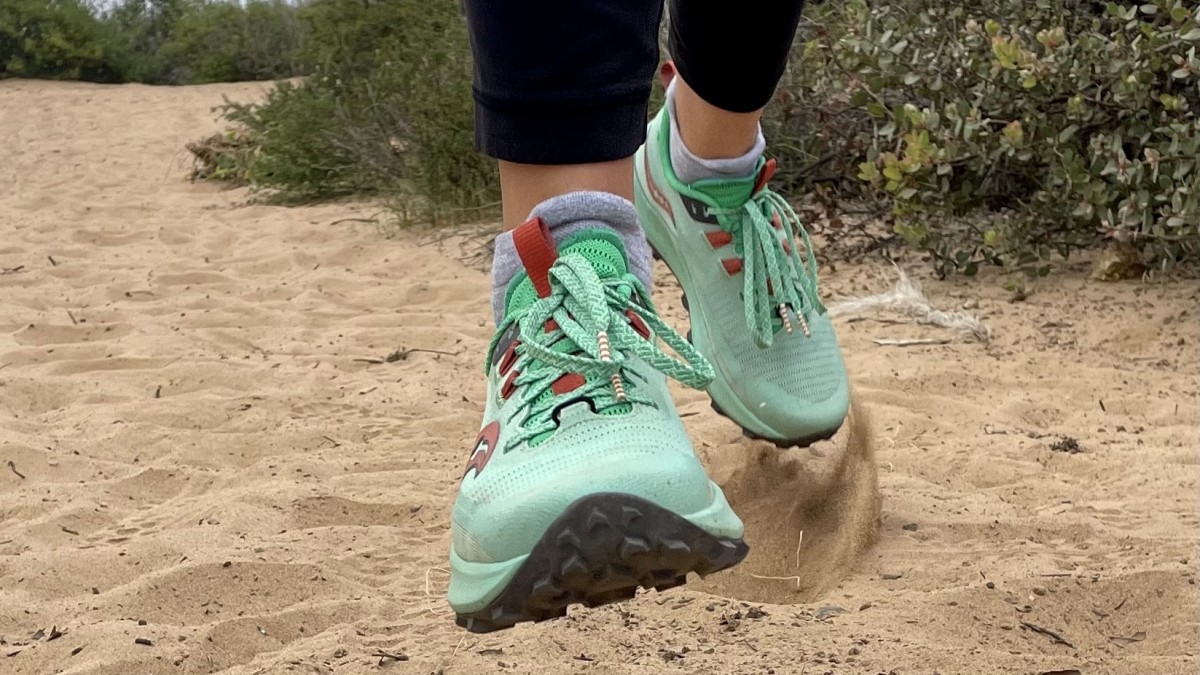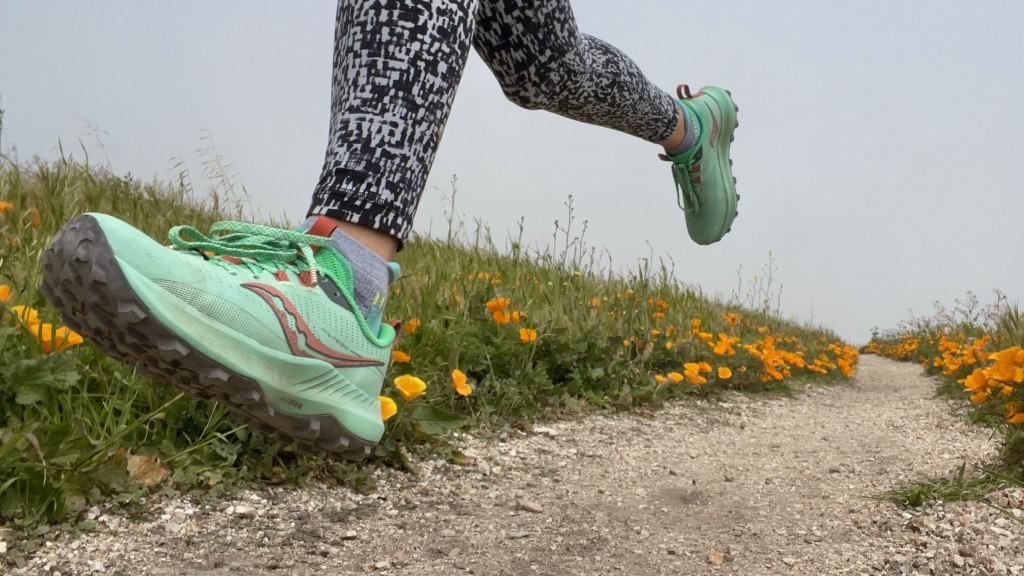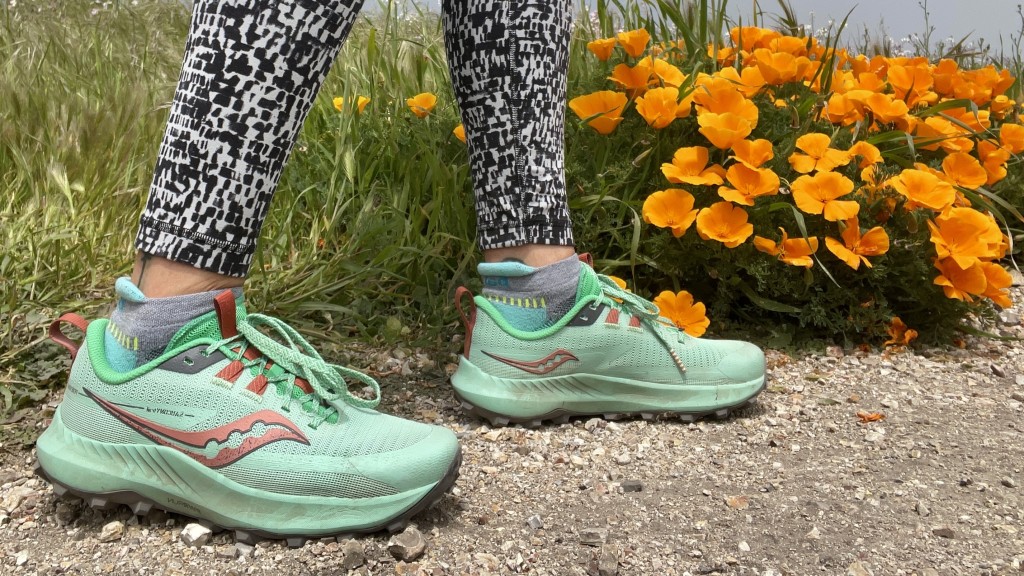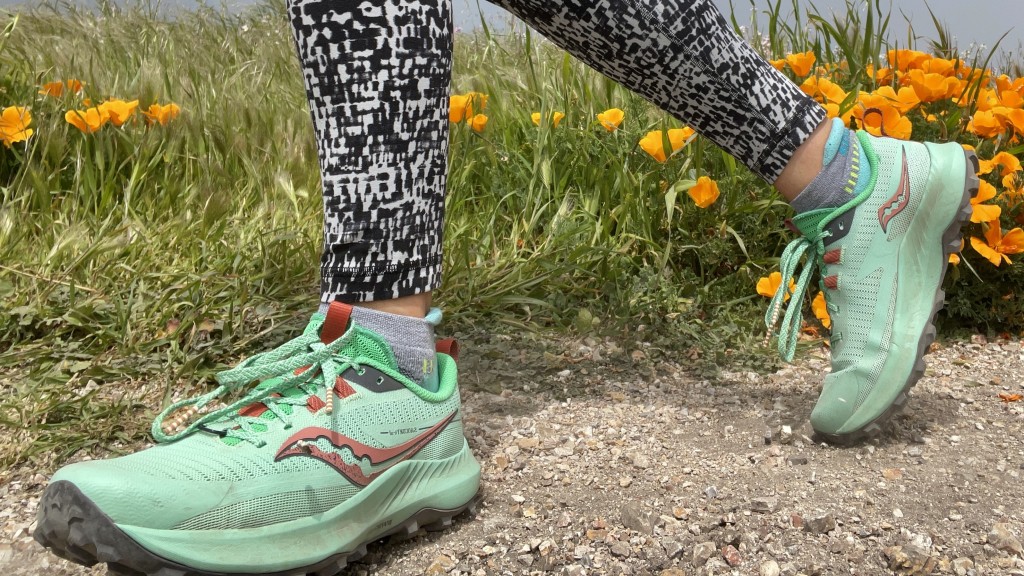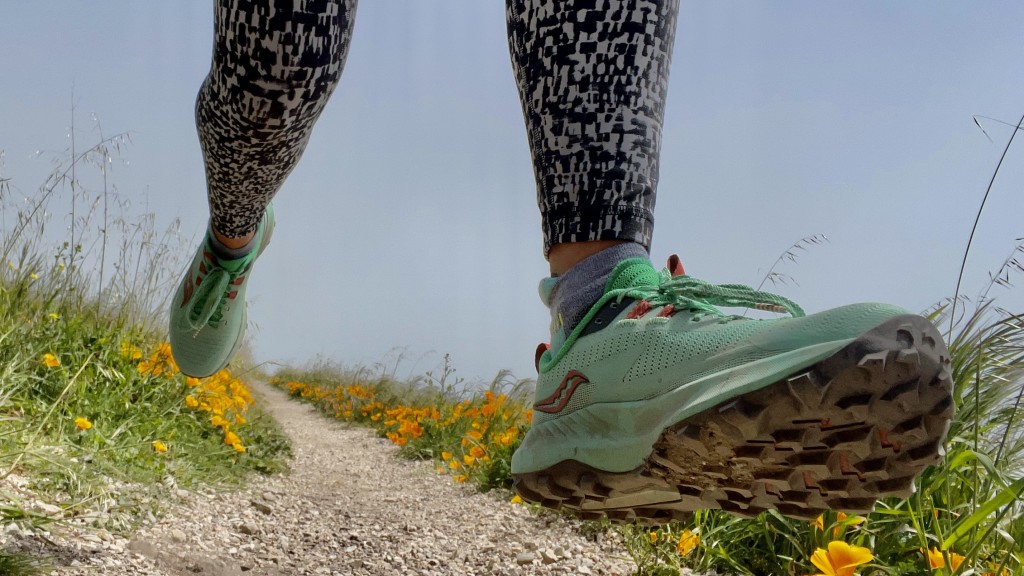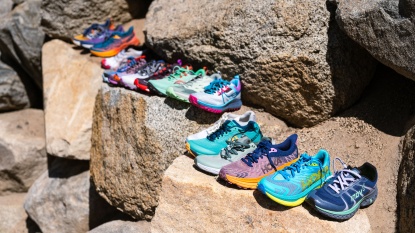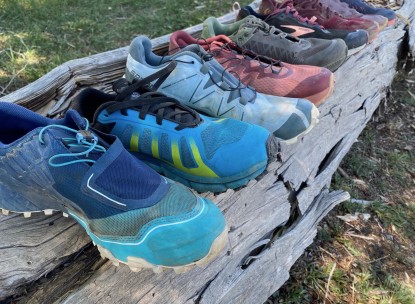Our Verdict
Compare to Similar Products
 This Product
Saucony Peregrine 13 - Women's | |||||
|---|---|---|---|---|---|
| Awards | |||||
| Price | $74.95 at Amazon Compare at 2 sellers | Check Price at Backcountry Compare at 2 sellers | Check Price at Backcountry Compare at 3 sellers | Check Price at Backcountry Compare at 3 sellers | $100 List $79.95 at Amazon |
Overall Score  |
|||||
| Star Rating | |||||
| Bottom Line | If you want a trail shoe that fits like a road shoe and can handle the demands of a rugged trail, this breathable and protective option is a great contender | This is our go-to recommendation for runners seeking a comfortable, well-tractioned shoe for short and long distances alike | Featuring an upgraded upper and a stable zero-drop design, this shoe is a dependable and comfortable trail running option, ensuring comfort even during extended runs | This is the shoe you want if you need something rugged to tackle slippery, muddy, and otherwise messy trails | An affordable and functional trail shoe that is perfect for new runners, budget-conscious runners, any anyone looking to tackle moderate terrain |
| Rating Categories | Saucony Peregrine 1... | Hoka Torrent 3 - Wo... | Altra Lone Peak 8 -... | Salomon Speedcross... | Brooks Divide 4 - W... |
| Foot Protection (25%) | |||||
| Traction (20%) | |||||
| Sensitivity (15%) | |||||
| Stability (15%) | |||||
| Comfort and Fit (15%) | |||||
| Weight (10%) | |||||
| Specs | Saucony Peregrine 1... | Hoka Torrent 3 - Wo... | Altra Lone Peak 8 -... | Salomon Speedcross... | Brooks Divide 4 - W... |
| Sizes Available | 5 - 12 US regular and wide |
5 - 11 US regular |
5.5 - 12 US regular and wide |
5 - 11 US regular and wide |
5 - 12 US regular |
| Measured Heel Stack Height | 28 mm | 26 mm | 23 mm | 34 mm | 29 mm |
| Measured Heel-to-Toe Drop | 4 mm | 5 mm | 0 mm | 13 mm | 8 mm |
| Rock Plate | Unknown Material | No | TPU | Not disclosed | No |
| Measured Lug Depth | 5 mm | 4 mm | 3.2 mm | 6 mm | 3 mm |
| Measured Weight | 7.59 oz | 7.52 oz | 8.14 oz | 8.54 oz | 7.82 oz |
| Upper | Mesh | Mesh | Ripstop Mesh | Textile/synthetic | Mesh |
| Midsole | PWRRUN foam | EVA | Altra EGO | Energy Cell+ | DNA Loft |
| Outsole | PWRTRAC rubber | Rubber | MaxTrac | Rubber | TrailTack rubber |
| Heel Tab Type | Finger loop | None | Finger loop | None | None |
Our Analysis and Test Results
The Peregrine 13 has been reconfigured to include more cushion throughout, ultimately creating a more comfortable underfoot ride. The addition of cushion added 1.5mm to the entire stack, leaving us with a moderately cushioned 28mm and 24mm stack in the heel and the forefoot, respectively.
Performance Comparison
Foot Protection
It is becoming increasingly popular for trail shoes to be released sans rock plate. The Peregrine hasn't conformed yet and was released, yet again, with a super functional rock plate. This time around, the added underfoot cushion prevents you from feeling the plate as readily beneath your feet. These two elements come together for added underfoot protection, served up with a side of bouncy responsiveness.
The toe bumper is significantly thicker and more protective than the thin rubber that encased the toe of the previous model of the Peregrine. This thicker design provides even more protection in the case of accidental rock kicks. The mesh upper is still breathable but does a good job of keeping particulate matter out. The upper is somewhat protective, though not the best we've seen. The moderately permeable upper mesh prevents us from recommending this shoe for sloppy terrain, even though we found that the traction holds up to demands.
The additional cushion around the heel collar creates a tighter seal, so to speak, so we never had any issue with sand and debris sneaking in through those points. If you like running in ankle gaiters, Peregrine 13 has a D-ring anchor point centered on the lacing system. We splashed through plenty of trickling streams and never felt particularly uncomfortable after chilly water seeped in. The Peregrine dries quickly when splashed, but there are better options if you foresee a lot of wet, muddy running in your future and want to prioritize a more water-resistant shoe.
Traction
With multidirectional lugs and a PWRTRAC rubber outsole, the traction of the Peregrine 13 is equipped for many terrain types. Because of its less water-resistant upper, we don't recommend this trail shoe for sloppy trails, even though the outsole design is beautifully equipped for this mucky running.
The outsole of each Peregrine 13 is adorned with forward-facing, chevron-shaped lugs beneath the forefoot and multidirectional, chevron-shaped lugs beneath the heel. The chevron shape creates a dynamic traction pattern, with points facing in all different directions. With five hard corners per lug, this specified shape can bite down into trails medially and laterally. The tractioned outsole rubber doesn't extend beyond the platform of the shoe, unlike some of the more rugged designs we have tested. While extended rubber outsoles can be helpful in certain situations, this isn't an element that we missed while testing the Peregrine.
Out of the box, the lugs on the Peregrine 13 are texturized for additional traction. After about 15 miles of running, we noticed that this texture started to smooth out. Moreover, the lugs that take bigger beatings during toe-off and landing also showed signs of wear early on. A lot of our testing was executed on abrasive, rocky terrain, and while the outsole is grippy and secure, the signs of use appeared more quickly than we prefer. We noticed this, took notes, and ran an additional 13 miles on softer earth to compare. The signs of wear were negligible after these miles, urging us to conclude that the lugs of the Peregrine will last longer on less abrasive terrain. Though the Peregrine is a great shoe for new trail runners looking for a traditional-feeling fit, we do not recommend it as a crossover shoe because of the degradation, albeit minor, of the lugs.
Sensitivity
We have been using the word “nimble” a lot, which is how we feel when a shoe nails the balance between sensitivity and security. Some trail runners love feeling every bit of trail info beneath their feet, while others prefer having less of that sensation. If you don't know what you are looking for in terms of sensitivity, the Peregrine is a great shoe to take for a spin.
The sensitivity of the Peregrine 13 is middling in the best of ways. Even with a 28mm stack in the heel and 24mm in the front, the outsole is flexible enough to provide adequate sensitivity. The sensitivity is dampened a bit by the protective rock plate housed in the landing platform, which is why the Peregrine is a great shoe for runners who aren't sure what kind of trail experience they are after.
The sensitivity is such that your body will understand and adjust to the trail beneath it, but it is not so intense that it will leave the soles of your feet feeling tender after every run.
Stability
Much like its predecessor, the Peregrine 13 is a stable shoe for runners whom it fits. With a 4mm drop and a slender midfoot, this shoe is stable. Our caveat is that the platform is narrow, which can feel less stable for wider-footed runners.
Because the outsole doesn't extend beyond the shoe's platform, the base of support is narrower than models that scored the highest in this metric. This sensation can feel unstable and squirrely to runners with wider feet. Saucony does make a wide version of the Peregrine, which may help mitigate this. The strong lateral structure and the heel cup provide lateral stability, so if the shoe fits, wear it. But if you are a runner with wide feet on the hunt for a stable shoe, we have other recommendations for you.
Comfort and Fit
The recent updates to the Peregrine greatly increased its comfort. The additional cushion throughout took a shoe that felt like comfort was an afterthought and turned it into a shoe suitable for marathon efforts.
The upper mesh feels rigid out of the box but is quickly molded to provide a personalized fit throughout the upper. The comfort of the cushion throughout the base and heel cup make this version of the Peregrine one that we feel comfortable recommending to rookies and ultra-distance runners who aren't looking for a plush shoe but want something comfortable.
The Peregrine is not a shoe that we would call “universally comfortable.” The narrow midfoot gives way to a rather unremarkable toe box. It certainly isn't a narrow toe box, but if you want space for toes to splay, this is not the shoe for you. These shoes fit true to size, and a wide version is available, but if you have wide feet or prefer a bit of extra wiggle room, this might not be your best choice. Conversely, the overall fit of the Peregrine is reminiscent of a traditional road shoe, which makes it a comfortable option for runners who want to give trail shoes a try.
Weight
A women's size 6.5 Peregrine 13 weighs 7.59 ounces for each shoe, which is quite low when considering the protective tech stashed within the design.
The thick lugs, rock plate, and updated toe bumper all add weight to what is otherwise a lightweight and breathable shoe. Even still, this version of the Peregrine was among the lightest. If you are looking for an ultralight experience, there are a couple of other options that will save you ounces. Overall, though, the Peregrine offers a ton of protection for very little relative weight.
Should You Buy the Saucony Peregrine 13?
The Peregrine isn't our first pick for runners who want to run long distances because it isn't as well-cushioned as some of the more distance-focused options. If middle or short distances are your game, the Peregrine is a great choice. With plenty of responsive bounce to help you bound down the trail, this traditionally-shaped runner is great for summer running.
What Other Trail Running Shoes Should You Consider?
For a shoe that splits the difference between comfort and rugged capabilities, try our Editor's Choice award winner, the Hoka Torrent 3. If you like the idea of a more traditional-feeling trail shoe, the New Balance Fresh Foam Hierro v7 is a slightly softer trail shoe with a similar fit as the Peregrine. The Hoka Challenger 7 offers a chunkier underfoot stack, but is equally capable when it comes to tearing up your local trails.


